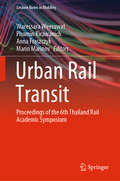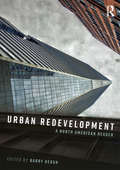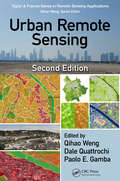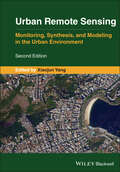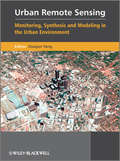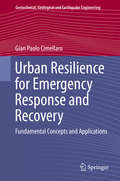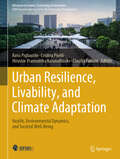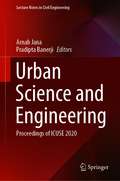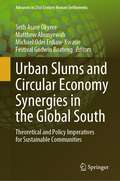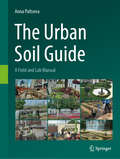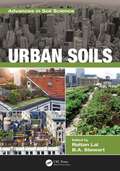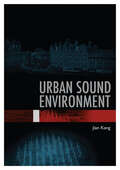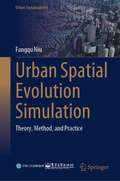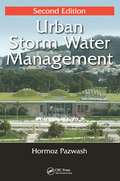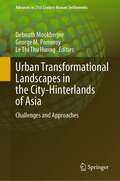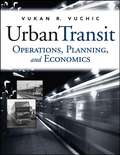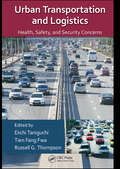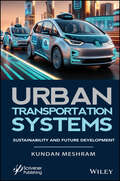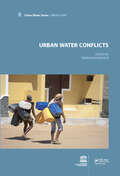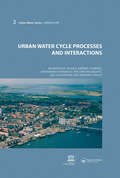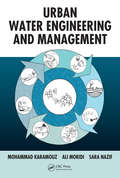- Table View
- List View
Urban Rail Transit: Proceedings of the 6th Thailand Rail Academic Symposium (Lecture Notes in Mobility)
by Waressara Weerawat Phumin Kirawanich Anna Fraszczyk Marin MarinovThese proceedings gather a selection of peer-reviewed papers presented at the 6th Thailand Rail Academic Symposium (TRAS 2019), held at Mahidol University, Bangkok, Thailand on 21–22 November 2019. The focus is on presenting recent research on issues related to rail and metro, with a specific focus on metro performance and system design undertaken in Thailand, South East Asia and beyond. Topics presented are divided into three themes and cover issues related to: Metro operations and system performance Rail engineering and vehicles Rail education and training
Urban Redevelopment: A North American Reader
by Barry HershUrban redevelopment plays a major part in the growth strategy of the modern city, and the goal of this book is to examine the various aspects of redevelopment, its principles and practices in the North American context. Urban Redevelopment: A North American Reader seeks to shed light on the practice by looking at both its failures and successes, ideas that seemed to work in specific circumstances but not in others. The book aims to provide guidance to academics, practitioners and professionals on how, when, where and why, specific approaches worked and when they didn’t. While one has to deal with each case specifically, it is the interactions that are key. The contributors offer insight into how urban design affects behavior, how finance drives architectural choices, how social equity interacts with economic development, how demographical diversity drives cities’ growth, how politics determine land use decisions, how management deals with market choices, and how there are multiple influences and impacts of every decision. The book moves from the history of urban redevelopment, The City Beautiful movement, grand concourses and plazas, through urban renewal, superblocks and downtown pedestrian malls to today’s place-making: transit-oriented design, street quieting, new urbanism, publicly accessible, softer, waterfront design, funky small urban spaces and public-private megaprojects. This history also moves from grand masters such as Baron Haussmann and Robert Moses through community participation, to stakeholder involvement to creative local leadership. The increased importance of sustainability, high-energy performance, resilience and both pre- and post-catastrophe planning are also discussed in detail. Cities are acts of man, not nature; every street and building represents decisions made by people. Many of today’s best recognized urban theorists look for great forces; economic trends, technological shifts, political movements and try to analyze how they impact cities. One does not have to be a subscriber to the "great man" theory of history to see that in urban redevelopment, successful project champions use or sometimes overcome overall trends, using the tools and resources available to rebuild their community. This book is about how these projects are brought together, each somewhat differently, by the people who make them happen.
Urban Remote Sensing (Remote Sensing Applications Series)
by Qihao Weng Dale Quattrochi Paolo E. GambaUrban Remote Sensing, Second Edition assembles a team of professional experts to provide a much-needed update on the applications of remote sensing technology to urban and suburban areas. This book reflects new developments in spaceborne and airborne sensors, image processing methods and techniques, and wider applications of urban remote sensing to meet societal and economic challenges. In various sections of the book the authors address methods for upscaling urban feature extraction to the global scale, new methods in mapping and detecting urban landscape features and structures, and mapping and monitoring urbanization in developing countries. Additionally, readers are provided with valuable case studies such as the HEAT (Heat Energy Assessment Technologies) project in Calgary, Canada and the use of VHR (very high resolution) satellite monitoring in Salzburg, Austria to tackle challenges of urban green planning. Features Explores the most up-to-date developments in the field of urban remote sensing Integrates both technical and practical aspects covering all different topics of global urban growth issues Provides new and updated contributions addressing data mining of remotely sensed big data, recent urban studies on a global scale, accuracy assessment and validation, and new technical challenges Examines various applications of urban remote sensing in support of urban planning, environmental management, and sustainable urban development Authors are renowned figures in the field of remote sensing
Urban Remote Sensing: Monitoring, Synthesis and Modeling in the Urban Environment
by Xiaojun YangThe second edition of Urban Remote Sensing is a state-of-the-art review of the latest progress in the subject. The text examines how evolving innovations in remote sensing allow to deliver the critical information on cities in a timely and cost-effective way to support various urban management activities and the scientific research on urban morphology, socio-environmental dynamics, and sustainability. Chapters are written by leading scholars from a variety of disciplines including remote sensing, GIS, geography, urban planning, environmental science, and sustainability science, with case studies predominately drawn from North America and Europe. A review of the essential and emerging research areas in urban remote sensing including sensors, techniques, and applications, especially some critical issues that are shifting the directions in urban remote sensing research. Illustrated in full color throughout, including numerous relevant case studies and extensive discussions of important concepts and cutting-edge technologies to enable clearer understanding for non-technical audiences. Urban Remote Sensing, Second Edition will be of particular interest to upper-division undergraduate and graduate students, researchers and professionals working in the fields of remote sensing, geospatial information, and urban & environmental planning.
Urban Remote Sensing
by Xiaojun YangUrban Remote Sensing is designed for upper level undergraduates, graduates, researchers and practitioners, and has a clear focus on the development of remote sensing technology for monitoring, synthesis and modeling in the urban environment. It covers four major areas: the use of high-resolution satellite imagery or alternative sources of image date (such as high-resolution SAR and LIDAR) for urban feature extraction; the development of improved image processing algorithms and techniques for deriving accurate and consistent information on urban attributes from remote sensor data; the development of analytical techniques and methods for deriving indicators of socioeconomic and environmental conditions that prevail within urban landscape; and the development of remote sensing and spatial analytical techniques for urban growth simulation and predictive modeling.
Urban Resilience for Emergency Response and Recovery
by Gian Paolo CimellaroThis book introduces the concepts of Resilience-Based Design (RBD) as an extension of Performance-Based Design. It provides readers with a range of cutting-edge methodologies for evaluating resilience and clarifies the difference between resilience, vulnerability and sustainability. Initially, the book focuses on describing the different types of uncertainty that arise in the context of resilience evaluation. This is followed by an entire chapter dedicated to the analytical and experimental recovery functions. Then, starting from the definition of resilience provided by MCEER, an extension of the methodology is provided that introduces the seven dimensions of Community Resilience, summarized in the acronym PEOPLES. They are: Population and Demographics, Environmental/Ecosystem, Organized Governmental Services, Physical infrastructures, Lifestyle and Community Competence, Economic Development, and Socio-Cultural Capital. For each dimension, components and subcomponents are defined and the related indices are provided. Underlining the importance of the physical infrastructure dimension, the book provides several examples of applications for transportation, hydraulic, gas and power networks. The problem of interdependencies and the domino effect is also taken into account during the analysis. One of the book's closing chapters focuses on different methodologies for improving disaster preparedness and engineering mitigation strategies, while the last chapter describes the different computer platforms available on the market for evaluating Community Resilience. The book offers readers an extensive introduction to the concept of Resilience-Based Design, together with selected advanced applications for specialists. No prerequisite knowledge is needed in order to understand the book, and the Appendix offers valuable supplemental information on e. g. the probabilistic concepts. As such, the book offers a valuable resource for graduate students, young engineers and researchers who are interested in the topic, and can also be used as a supplementary text in graduate level Disaster Resilience courses.
Urban Resilience for Risk and Adaptation Governance: Theory and Practice (Resilient Cities)
by Grazia Brunetta Ombretta Caldarice Nicola Tollin Marti Rosas-Casals Jordi MoratóThis book brings together a series of theory and practice essays on risk management and adaptation in urban contexts within a resilient and multidimensional perspective. The book proposes a transversal approach with regard to the role of spatial planning in promoting and fostering risk management as well as institutions’ challenges for governing risk, particularly in relation to new forms of multi-level governance that may include stakeholders and citizen engagement. The different contributions focus on approaches, policies, and practices able to contrast risks in urban systems generating social inclusion, equity and participation through bottom-up governance forms and co-evolution principles. Case studies focus on lessons learned, as well as the potential and means for their replication and upscaling, also through capacity building and knowledge transfer. Among many other topics, the book explores difficulties encountered in, and creative solutions found, community and local experiences and capacities, organizational processes and integrative institutional, technical approaches to risk issue in cities.
Urban Resilience, Livability, and Climate Adaptation: Health, Environmental Dynamics, and Societal Well-Being (Advances in Science, Technology & Innovation)
by Cristina Piselli Claudia Fabiani Hirushie Pramuditha Karunathilake Ilaria PigliautileThis book explores urban environments and their impact on resilience, livability, climate adaptation, health, and societal well-being. It provides interdisciplinary insights for fostering resilient, livable, and sustainable cities prioritizing well-being and quality of life for all residents. The book covers various topics and discusses innovative approaches for incorporating nature into urban planning. It also examines the relationships between diet diversity, food environments, and transportation systems. Spatial analysis of noise contour maps based on traffic speed is conducted, along with an assessment of the impact of office environments on productivity. The book explores the influence of streetscapes on anxiety, envisions future cities from a youth perspective, and identifies critical factors affecting the design and use of elevated urban spaces. Daylighting performance in school expansions is evaluated, and the concept ofa livable city is examined. Community adaptive capacity for climate-resilient development is assessed through a case study analysis. The livability of street vendors in different urban contexts is compared, and alternative perspectives on restorative environments are presented. The book investigates the impact of urban refugees on cities and reevaluates scientific theories for human well-being-oriented built environments. It evaluates tourist satisfaction with urban railway systems and explores sport as a tool for healthy and sustainable cities.
Urban Science and Engineering: Proceedings of ICUSE 2020 (Lecture Notes in Civil Engineering #121)
by Arnab Jana Pradipta BanerjiThis book comprises select proceedings of the First International Conference on Urban Science and Engineering. The focus of the conference was on the milieu of urban planning while applying technology which ensures better urban life, coupled with sensitivity to depleting natural resources and focus on sustainable development. The contents focus on sustainable infrastructure, mobility and planning, urban water and sanitization, green construction materials, optimization and innovation in structural design, and more. This book aims to provide up-to-date and authoritative knowledge from both industrial and academic worlds, sharing best practice in the field of urban science and engineering. This book is beneficial to students, researchers, and professionals working in the field of smart materials and sustainable development.^
Urban Slums and Circular Economy Synergies in the Global South: Theoretical and Policy Imperatives for Sustainable Communities (Advances in 21st Century Human Settlements)
by Seth Asare Okyere Matthew Abunyewah Michael Odei Erdiaw-Kwasie Festival Godwin BoatengThis book takes a theoretical and empirical distance from urban slums/low-income settlements as a threat to environmental sustainability and recast them as places where environmentally rehabilitative and circular practices occur—drawing on the theoretical lens of the circular economy (CE). CE is defined as regenerative system that minimizes waste, emission, and energy leakage by slowing, closing, and narrowing material and energy loops. In principle, CE departs from the traditional linear model of take-make-use-dispose. As conceived in urban contexts, circular cities offer possibilities to regenerate natural systems, design out waste, and keep products in use. While the CE key principles of reduce, repair, and reuse are essential to the sustainable and inclusive interventions in urban slums, there is lack of case studies exploring the role of place and agency, especially the slum living-CE nexus in global south contexts. In inequitable urban transitions, a nuanced understanding of thesynergies between urban slums and the circular economy is not only theoretically relevant for reconceptualizing the slum in urban sustainability discourses but also exert policy and practice ramifications to decidedly figure out how the urban slum phenomenon can foster the sustainable and inclusive development of marginal areas through contextual and people-centered initiatives.
The Urban Soil Guide: A Field and Lab Manual
by Anna PaltsevaDelve into the fascinating world of soil science with "The Urban Soil Guide," a comprehensive manual designed for everyone from science beginners to seasoned horticulturists. Whether you're an introductory science student, a passionate gardener, a landscape designer, or a professional horticulturist, this guide is tailored for you. Packed with a variety of hands-on activities, this guide makes learning soil science both accessible and enjoyable. From simple experiments that can be performed in your kitchen to more advanced techniques, it offers a practical approach to understanding soil. Written by a soil scientist, this guide bridges the gap between professional knowledge and amateur enthusiasm. The Urban Soil Guide is versatile enough to serve as a textbook in botanical gardens and university classes, while also being an invaluable resource for amateurs. Choose activities that match your interest and level of expertise. Embark on your journey to becoming a soil expert with The Urban Soil Guide – your hands-on companion in the world of soil science.
Urban Soils (Advances in Soil Science)
by Rattan Lal B. A. StewartGlobally, 30% of the world population lived in urban areas in 1950, 54% in 2016 and 66% projected by 2050. The most urbanized regions include North America, Latin America, and Europe. Urban encroachment depletes soil carbon and the aboveground biomass carbon pools, enhancing the flux of carbon from soil and vegetation into the atmosphere. Thus, urbanization has exacerbated ecological and environmental problems. Urban soils are composed of geological material that has been drastically disturbed by anthropogenic activities and compromised their role in the production of food, aesthetics of residential areas, and pollutant dynamics. Properties of urban soils are normally not favorable to plant growth—the soils are contaminated by heavy metals and are compacted and sealed. Therefore, the quality of urban soils must be restored to make use of this valuable resource for delivery of essential ecosystem services (e.g., food, water and air quality, carbon sequestration, temperature moderation, biodiversity). Part of the Advances in Soil Sciences Series, Urban Soils explains properties of urban soils; assesses the effects of urbanization on the cycling of carbon, nitrogen, and water and the impacts of management of urban soils, soil restoration, urban agriculture, and food security; evaluates ecosystem services provisioned by urban soils, and describes synthetic and artificial soils.
Urban Sound Environment
by Jian KangOver the past two decades there have been many major new developments in the field of urban sound environment. Jian Kang introduces and examines these key developments, including:the development of prediction methods for urban sound propagationestablishment and application of noise-mapping softwarenew noise control measures and design methods.Also
Urban Spatial Evolution Simulation: Theory, Method, and Practice (Urban Sustainability)
by Fangqu NiuThis book provides a comprehensive introduction to the LUTI model from many aspects such as principles, methods and practice. Since the geometric revolution in the 1960s, model simulation methods have been used in some developed countries to study the development process of urban space and to support urban spatial decision making. One of the most common models is the Land Use Transport Interaction (LUTI) model. At present, relevant research is also gradually emerging in developing countries. This book has the following features: 1. The theory and methods of urban spatial development simulation have been systematically summarised, and practical application research has been carried out. 2. The LUTI model has been systematically explored from theory and implementation method to application practice. 3. The "activity-based" modelling techniques used are at the forefront of LUTI model development.
Urban Storm Water Management
by Hormoz PazwashDesign Drainage and Storm Water Management Systems Efficiently Urban Storm Water Management, Second Edition covers the design, installation, and maintenance of storm water management systems, addresses the impact of urban development on runoff and infiltration, and focuses on storm water management relative to flooding and water pollution. Recogniz
Urban Stormwater and Flood Management: Enhancing the Liveability of Cities (Applied Environmental Science and Engineering for a Sustainable Future)
by Veeriah Jegatheesan Ashantha Goonetilleke John Van Leeuwen Jaya Kandasamy Doug Warner Baden Myers Muhammed Bhuiyan Kevin Spence Geoffrey ParkerThis book brings together the experiences of engineers and scientists from Australia and the United Kingdom providing the current status on the management of stormwater and flooding in urban areas and suggesting ways forward. It forms a basis for the development of a framework for the implementation of integrated and optimised storm water management strategies and aims to mitigate the adverse impacts of the expanding urban water footprint. Among other topics it also features management styles of stormwater and flooding and describes biodiversity and ecosystem services in relation to the management of stormwater and the mitigation of floods. Furthermore, it places an emphasis on sustainable storm water management measures. Population growth, urbanisation and climate change will pose significant challenges to engineers, scientists, medical practitioners, policy makers and practitioners of several other disciplines. If we consider environmental and water engineers, they will have to face challenges in designing smart and efficient water systems which are robust and resilient to overcome shrinking green spaces, increased urban heat islands, damages to natural waterways due to flooding caused by increased stormwater flow. This work provides valuable information for practitioners and students at both senior undergraduate and postgraduate levels.
Urban Transformational Landscapes in the City-Hinterlands of Asia: Challenges and Approaches (Advances in 21st Century Human Settlements)
by Debnath Mookherjee George M. Pomeroy Le Thi Thu HuongIn the context of mounting challenges stemming from a rapid transformation of the urban-regional landscapes in many Asian countries, this book highlights a multifaceted array of issues that increasingly engage the academic and planning communities in search of viable solutions to complex problems facing us. Even though cities continue to dominate development studies, urbanization of Asia is evolving toward a hybrid urban-rural nexus beyond the cities. This volume considers these shifting dynamics of Asian urbanization, including urban spatial transformations and their ramifications in the context of sustainability and planning. Through the lens of a set of empirical studies across diverse disciplines, geographies and methodologies. yet with an overarching concern for sustainability in varied (but interconnected) areas such as climate change, land use planning, infrastructure and urban mobility, and quality of life, these studies examine a range of important topics (e.g., flooding, transportation, housing, open space/ green space, urban garden and such) in city/regional settings. Together, they add insights into varied transformational processes or patterns at work on the urban-regional landscapes in a number of Asian countries while offering innovative approaches or alternatives. The proposed volume fills a gap in urban/regional studies in context of South and Southeast Asia that will be of interest to all stakeholders (e.g., planners, administrators, academicians and the citizenry), particularly those interested in sustainability and planning paradigms. It should be a timely and valuable addition to the Asian urbanization literature.
Urban Transit: Operations, Planning, and Economics
by Vukan R. VuchicThe only modern text to cover all aspects of urban transit operations, planning, and economics Global in scope, up-to-date with current practice, and written by an internationally renowned expert, Urban Transit: Operations, Planning, and Economics is a unique volume covering the full range of issues involved in the operation, planning, and financing of transit systems. Presenting both theoretical concepts and practical, real-world methodologies for operations, planning and analyses of transit systems, this book is a comprehensive single-volume text and reference for students as well as professionals. The thorough examination of technical fundamentals and management principles in this book enables readers to address projects across the globe despite nuances in regulations and laws. Dozens of worked problems and end-of-chapter exercises help familiarize the reader with the formulae and analytical techniques presented in the book's three convenient sections: Transit System Operations and Networks Transit Agency Operations, Economics, and Organization Transit System Planning Visually enhanced with nearly 250 illustrations, Urban Transit: Operations, Planning, and Economics is a reliable source of the latest information for transit planners and operators in transit agencies, metropolitan planning organizations, city governments, consulting firms as well as students of transportation engineering and city planning at universities and in professional courses.
Urban Transportation and Logistics: Health, Safety, and Security Concerns
by Eiichi Taniguchi Tien Fang Fwa Russell G. ThompsonAlthough society has become increasingly dependent on the timely operation of logistics systems, we still face many problems regarding efficiency, the environment, energy consumption, and safety in urban transport and logistics under normal cases and in disasters. As such, understanding how to address these challenges has become essential for creat
Urban Transportation Systems: Sustainability and Future Development
by Kundan MeshramThis exciting new volume covers the most up-to-date advances, theories, and practical applications for non-motorized transportation (NMT) systems, geographic information system-based transportation systems, and signal processing for urban transportation systems. This book will allow readers to readers to identify traffic and transport problems in cities and to study mass transportation systems, and modes of transportation and their characteristics, focusing on transportation infrastructure which includes green bays, control stations, mitigation buildings, separator lanes, and safety islands. From this, readers will be able to study urban public transport systems and gain some background into intelligent transportation and telemetric systems, including techniques for designing transport telemetric systems and applying them to urban transportation. Applications include advanced traffic management systems, advanced traveler information systems, advanced vehicle control systems, commercial vehicle operational management, advanced public transportation systems, electronic payment systems, advanced urban transportation, security and safety systems, and urban traffic control. From this, an artificial Intelligence-based transportation system design using genetic algorithms and neural networks is discussed, to show applications in designs. These models and their studies are further extended in signal processing systems and geographic information systems (GIS) to improve transportation system design, and to apply this to the design of non-motorized transportation models, while ensuring pedestrian safety. All these models are further analyzed for environmental impact assessment, which include structural audits, analysis of site selection procedure, baseline conditions and major concerns, green building and its advantages, the description of potential environmental effects, and many more interesting topics.
Urban Tree Management
by Andreas RoloffUrban tree management is the key basis for greener cities of the future. It is a practical discipline which includes tree selection, planting, care and protection and the overall management of trees as a collective resource. Urban Tree Management aims to raise awareness for the positive impacts and benefits of city trees and for their importance to city dwellers. It describes their advantages and details their effects on quality of urban life and well-being ? aspects that are increasingly important in these times of progressing urbanisation. With this book you will learn: fundamentals, methods and tools of urban tree management state of the art in the fields of urban forestry and tree biology positive effects and uses of urban trees features, requirements and selection criteria for urban trees conditions and problems of urban trees governance and management aspects environmental education programs. Edited by the leading expert Dr Andreas Roloff, Urban Tree Management is an excellent resource for plant scientists, horticulturists, dendrologists, arborists and arboriculturists, forestry scientists, city planners, parks department specialists and landscape architects. It will be an essential addition to all students and libraries where such subjects are taught.
Urban Water Conflicts: UNESCO-IHP (Urban Water Series)
by Bernard BarraqueUrban water conflicts manifested first in Europe in the 19th century and are observed nowadays in various forms throughout the world; in particular, in developing countries. Main causes of these conflicts are characterized by complex socioeconomic and institutional issues related to urban water management. The debate about public water services ver
Urban Water Cycle Processes and Interactions: Urban Water Series - UNESCO-IHP (Urban Water Series)
by Jiri MarsalekUrban Water Cycle Processes and Interactions represents the fruit of a project by UNESCO's International Hydrological Programme on this topic. The volume introduces the urban water cycle concept and the need for integrated or total management. It then explores in detail the manifold hydrological components of the cycle, the diverse elements of urban infrastructure and water services, and the various effects of urbanization on the environment - from the atmosphere and surface waters to wetlands, soils and groundwater, as well as biodiversity. A concluding series of recommendations for effective urban water management summarize the important findings set forth here.
Urban Water Engineering and Management
by Mohammad Karamouz Ali Moridi Sara NazifBased on the latest developments research, this book delineates a systems approach urban water hydrology, engineering, planning, and management. It covers a range of classic urban water management issues such as the modeling of urban water cycles, urban water supply and distribution systems, demand forecasting, wastewater and storm water collection and treatment.
Urban Water in Japan (Urban Water Series)
by Rutger De Graaf Fransje HooimeijerWater control is essential to Japan, as more than half of its invested capital is concentrated in elevations under sea level and the majority of the island nation is exceptionally vulnerable to flooding. To avoid potential crisis, the Japanese have developed exceptionally innovative water management practices. Offering the unique perspective of Dut
